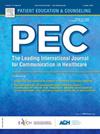Use of metaphor in provider-patient communication in medical settings: A systematic review
IF 2.9
2区 医学
Q2 PUBLIC, ENVIRONMENTAL & OCCUPATIONAL HEALTH
引用次数: 0
Abstract
Background
Metaphors are extensively utilized by those studying and practicing medicine. Those metaphors employed in provider-patient communication in medical settings are particularly significant due to their dynamic and interactive nature, and their direct contribution to the completion of core medical tasks and the quality of provider-patient interaction and relationship.
Objective
We aim to: (1) to identify and summarize existing literature on the use of metaphors in patient-provider communication in medical settings; (2) discuss the implications of these studies for medical research and practice; and (3) provide recommendations for future research in this area.
Methods
The Chinese National Knowledge Infrastructure and the Web of Science Core Collections were systematically searched, and the obtained literature was combined with the online resource "Metaphor in Health Discourse and Communication". The resultant literature was then screened according to preset inclusion and exclusion criteria.
Results
Of 265 articles identified, 16 studies were found to completely meet our purpose and inclusion criteria. Analysis revealed 7 major themes, including the metaphor’s facilitating functions, harmful effects, differences between providers and patients etc. Metaphors were found to enhance provider-patient relationship and communication and promote shared understanding and decision-making.
Conclusion
Metaphors play a significant role in provider-patient communication in medical settings, offering both benefits and challenges. Future research can further explore other aspects of metaphor use in medical settings, and update the research methodology and approaches by collecting larger, balanced samples of metaphor, conducting quantitative analyses of metaphor efficacy, and doing multimodal analysis of metaphor use.
隐喻在医疗环境中医患沟通中的应用:系统回顾
隐喻在医学研究和实践中被广泛使用。在医疗环境中,医患沟通中使用的这些隐喻尤其重要,因为它们具有动态性和互动性,并直接有助于完成核心医疗任务以及医患互动和关系的质量。目的我们的目的是:(1)识别和总结现有的文献隐喻在医疗环境中使用的医患沟通;(2)讨论这些研究对医学研究和实践的影响;(3)对该领域未来的研究提出建议。方法系统检索中国国家知识基础设施和Web of Science核心馆藏,并与在线资源“健康话语与传播中的隐喻”相结合。然后根据预设的纳入和排除标准对所得文献进行筛选。结果在265篇文献中,有16篇研究完全符合我们的目的和纳入标准。分析揭示了隐喻的促进作用、有害影响、医患差异等7大主题。研究发现,隐喻可以加强医患关系和沟通,促进共同理解和决策。结论隐喻在医疗环境中医患沟通中发挥着重要作用,既有益处,也有挑战。未来的研究可以进一步探索隐喻在医疗环境中使用的其他方面,并通过收集更大的、平衡的隐喻样本,进行隐喻功效的定量分析,以及隐喻使用的多模态分析来更新研究方法和方法。
本文章由计算机程序翻译,如有差异,请以英文原文为准。
求助全文
约1分钟内获得全文
求助全文
来源期刊

Patient Education and Counseling
医学-公共卫生、环境卫生与职业卫生
CiteScore
5.60
自引率
11.40%
发文量
384
审稿时长
46 days
期刊介绍:
Patient Education and Counseling is an interdisciplinary, international journal for patient education and health promotion researchers, managers and clinicians. The journal seeks to explore and elucidate the educational, counseling and communication models in health care. Its aim is to provide a forum for fundamental as well as applied research, and to promote the study of organizational issues involved with the delivery of patient education, counseling, health promotion services and training models in improving communication between providers and patients.
 求助内容:
求助内容: 应助结果提醒方式:
应助结果提醒方式:


